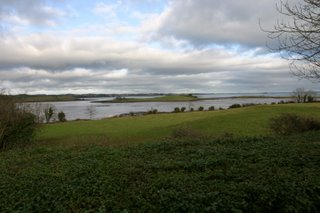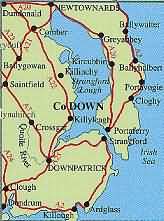
 This photo of island in better light from house. The brent geese are forming a circular group for protection, this usually happens when it is very windy for some reason.
This photo of island in better light from house. The brent geese are forming a circular group for protection, this usually happens when it is very windy for some reason.I am very fortunate to live about 200 yards from the south shore of Strangford Lough in Northern Ireland (30 miles south of Belfast) and 5 miles from Downpatrick (Where St.Patrick is supposed to be buried; it being his day today!) I look due north towards Killyleagh.
 Strangford Lough is a sea inlet that emerged from under the melting ice-sheets of the Ice Age and is for the most part less than 10m in depth. There is a deeper Y-shaped channel (possibly an old river-valley or geological fault-line) up to 66 m deep which extends from the Narrows up the central portion of the Lough.
Strangford Lough is a sea inlet that emerged from under the melting ice-sheets of the Ice Age and is for the most part less than 10m in depth. There is a deeper Y-shaped channel (possibly an old river-valley or geological fault-line) up to 66 m deep which extends from the Narrows up the central portion of the Lough.The surface of the bed and the indented shore of the Lough ranges from bedrock in areas with strong currents to fine mud in sheltered waters. The west shore has numerous islands typical of flooded drumlin topography.
The Lough contains extensive areas of mudflat and also sandflats (mainly at the northern end), with gravel, cobble, boulder and rocky shores as one moves further south. It also has areas of saltmarsh, the most extensive being in the Comber river estuary.
The water in the Lough is virtually fully saline except at the mouths of the two moderate-sized rivers, the Comber and the Quoile, and where several streams drain into it from the catchment of about 900 km² where it may be somewhat brackish.
The area has a mild climate with relatively low rainfall compared with other areas of Ireland, infrequent frosts and prevailing west to southwest winds.
Strangford Lough attracts vast numbers of wildfowl, waders, gulls and auks which overwinter on the Lough or stage here. Around 70,000 birds are present each winter. The Lough is an essential stop-over by these birds. July sees waders such as dunlin, turnstone, black and bar-tailed godwits. Autumn brings up to 15,000 Brent geese. Flocks of knot, dunlin, curlew, redshank and oystercatcher build up over the winter. Wildfowl such as wigeon and teal arrive from eastern Europe, whooper swans fly down from Iceland, while shelduck mass and rank across the sandflats. Breeding birds include sandwich, arctic and common terns, black-headed gulls, eider, mallard, merganser, canada geese, oystercatcher, ringed plover and cormorants.
This morning I dropped my wife in Belfast and made my way to the RSPB Bird Hide on Belfast Lough
where I was able to increase my list. There were 40+ linnets,reed buntings,1 goldcrest,1brambling,20 Blacktailed Godwit,loads of Teal,4 Red Breasted Merganser, 1 Green Winged Teal,1 Buzzard and innumerous Gulls,(Herring,Lesser and Greater Black Backed ,Common and Black headed) There was talk of a Caspian that had been seen the day before but to no avail. Paul Kelly was there from www.irishbirdimages.com.
2006 Bird List update
102. Linnet Carduelis cannabina
103. Lesser Black-backed Gull Larus Fuscus
No comments:
Post a Comment